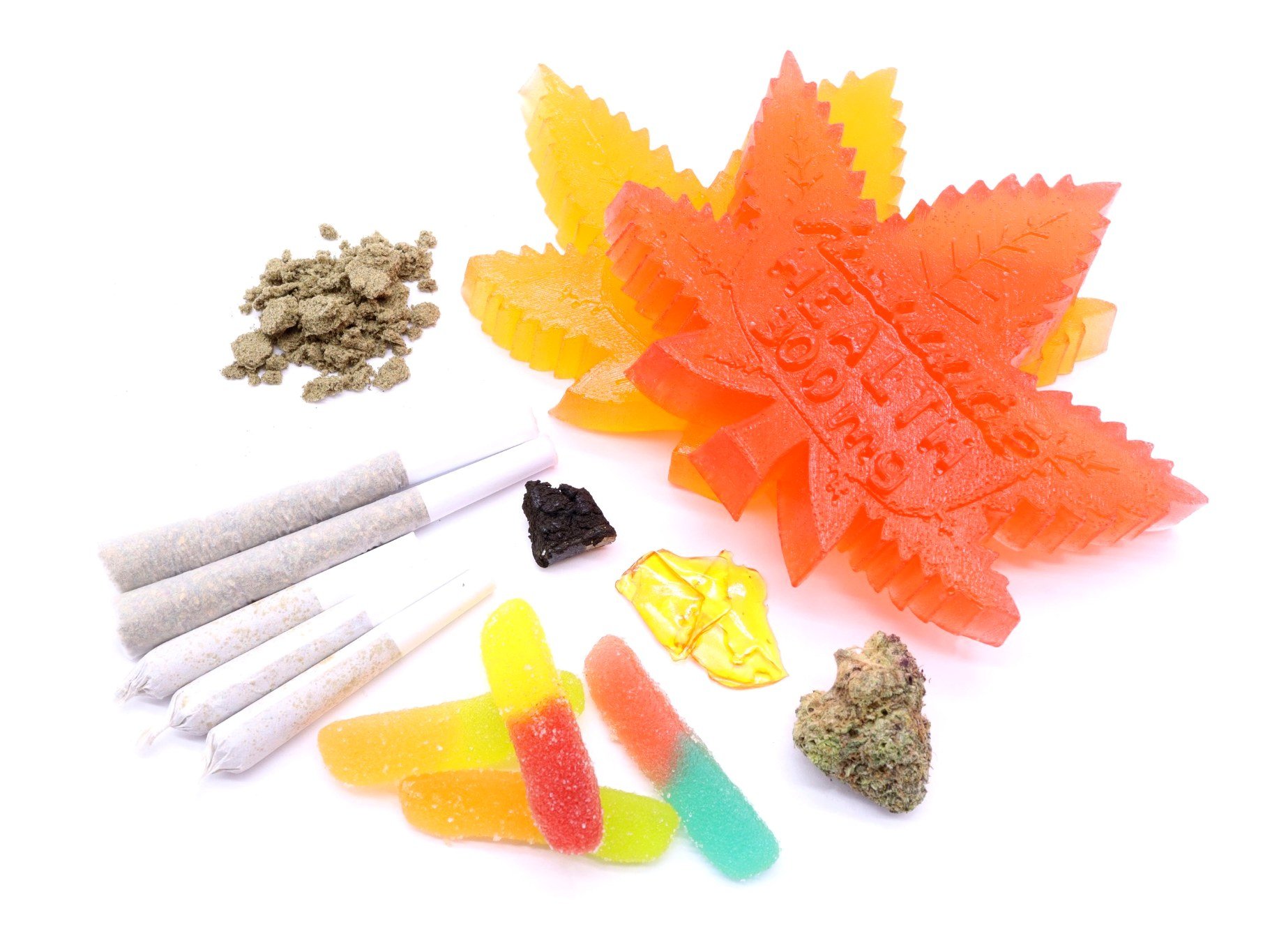What are two things you’re told you should never mix? Coffee and alcohol? Hot chocolate and ice cream? Oil and water? There are a lot of things that don’t mix well together, especially when we’re talking about consuming them together. Our digestive systems and cognitive functions can suffer at the hands of certain food or beverage concoctions, but what about combining psychedelic substances? Is it safe to take LSD and weed together?
Now this is a combination you’ll want to avoid, unless you’re a seasoned psychonautic veteran, familiar with all of the trippiest brain-melters out there. LSD and weed aren’t typically two things associated with one another – unless you’re talking about ‘things that are illegal in most parts of the world’. Instead of discussing the merits of taking a serious psychedelic substance like LSD and combining it with cannabis, we’d like to compare the potential benefits of Lysergic acid diethylamide with those of marijuana.
What is LSD? What are some of the uses for LSD today? What kind of research is being done on the benefits of LSD vs marijuana? Let’s get high on knowledge and trip out on the facts of LSD and weed.
WHAT IS LSD?
Lysergic acid diethylamide, better known as LSD, is a potent psychedelic substance that was originally derived from fungi. Discovered almost accidentally in 1938 by Swiss scientist Alber Hofmann, LSD was collected from rye fungus and was being studied when it came into contact with Hofmann’s skin. He felt its powerful psychedelic effects and committed to exploring its influences, potential uses and practical benefits.
Leading up to the 1950’s, LSD was showing some promising results as Hofmann and others continued to study the substance and all its characteristics. Despite its effectiveness as a therapeutic drug for a variety of mental health conditions, LSD made it into the limelight and became heavily stigmatized. The 1950’s, 60’s and 70’s were a dark period for forward-thinking as stigmas around LSD and weed as well as other substances took root in societies all over the globe.
Before any practical uses for LSD were given a chance, it was classified as a Schedule 1 controlled substance and further study ground to a halt. What is LSD? Essentially, it is a misunderstood, demonized and prohibited substance that could potentially have profoundly positive effects on people, if managed correctly.
Today, thanks to a resurgence in interests about psychedelics like DMT, ketamine, ayahuasca, psilocybin and others, Lysergic acid diethylamide is being looked at again for its potential benefits to neurological health. Certain practices like microdosing or dosing LSD in specific doses to help process trauma have gained popularity in recent years. As we begin to retrace our steps towards psychedelic enlightenment, the positive effects of substances like LSD and weed are beginning to outweigh the negatives that have held sway for so long.
Understanding ‘what is LSD’ requires a look at the kinds of effects it can have on your brain & body. Before we move onto some of the uses for LSD and determine what separates LSD vs marijuana, here is a quick summary of the most commonly reported positive/negative effects associated with Lysergic acid diethylamide:
POSITIVE EFFECTS
Episodes of creativity & imaginativeness
Enhanced sensory perceptions (colors, shapes, sounds, textures, etc)
Hallucinatory images, patterns, experiences
Dissolution of the ego
Long-lasting euphoria
Sense of oneness with other beings, energies or planes of existence
Changes in consciousness
Powerful emotions
Spiritual or cosmic experiences
Shifting of priorities, perceptions of reality
Ability to process information or experiences (both good and bad)
Eye-opening experiences with otherworldly entities
NEGATIVE EFFECTS
Losing track of time
Inability to focus
Overpowering hallucinations
Disturbing thought patterns or manners of speaking
Paranoia, anxiety or depression
Overwhelming emotions
Intense fears come to life
Intense, confusing experiences with otherworldly entities
These are just the most common experiences with LSD. Uses for LSD aren’t always medical in nature – many people consume this powerful psychedelic for recreational purposes too. Your mental health, mood, physical health, fitness, restfulness and diet can all have impacts on how you trip on LSD. More importantly, your tolerance to psychedelics and experience with these kinds of substances will determine whether you have a positive experience, or a negative one.
We will consider the pros & cons of both LSD and weed, but first we should review the uses for LSD in order to determine how it is helping people today.
USES FOR LSD
MENTAL HEALTH TREATMENT
Psychedelics like ayahuasca, psilocybin and LSD have demonstrated great potential as short- and long-term treatments for serious mental conditions like anxiety, depression, substance abuse/addiction and PTSD. When dosed effectively, LSD can assist patients in managing their anxiety, stress, insomnia, mood swings, depression and mental/physical trauma. A number of studies have been conducted on these particular uses for LSD since the 1950’s, and almost all of the findings have shown great therapeutic rewards with minimal risks.
How does LSD help a person process trauma or overcome neurological conditions? By opening up their mind’s eye, expanding consciousness and enhancing their abilities to perceive themselves and the world around them, patients can work through what ails them at the cognitive level. Psychedelics like LSD can certainly turn your emotions into overdrive or spiral your thoughts out of control, but if doses are optimized to your tolerance levels (i.e. microdosing, intermittent dosing, etc) then LSD can empower someone to reassess their trauma from new angles, or with new understandings from their enhanced perspectives.
OCD, end-of-life-anxiety, migraines, depression, addiction, insomnia or even nightmares can be confronted while under the influences of LSD. In this heightened state, a person might be more in tune with themselves or the universe they inhabit, leading them to self-evaluate and make changes where necessary.
REST & RELAXATION THERAPY
One of the most profound uses for LSD happens to center around, well… nothing. Doing nothing and just enjoying the experiences brought on by a psychedelic like LSD is sometimes the best thing to do for your health & wellbeing. Whether you’re microdosing for some cerebral calm or doing significant doses of 200 mcg or more to zone out, what is LSD if not a powerful ingredient for recontextualizing everything in your conscious mind?
Psychedelics have found a home at many treatment centers, retreats or guided sessions because they can level the playing field for anyone trying to process trauma, overcome their fears or to find peace amongst the chaos of life. This last point in particular has become quite popular among psychonauts – getting high on LSD, psilocybin or other psychedelics in order to reset their brain. Relaxing or unplugging from the seriousness of life can be impossible for some people, so a substance like LSD can be very beneficial for relaxing, resting or finding inner peace.
Imagine inside your brain is a vast lake with ebbs and flows, raging storms of anxiety and stress or quiet moments of blissful relaxation.. You are in a canoe – your consciousness – and your attempts to navigate through the tides of your mental state can seem like paddling against the currents much of the time. Psychedelics like LSD are like a sail for your small canoe, allowing you to put down your oars and focus on the horizon while your ship sails ahead, confidently.
This analogy was verbatim described by someone from a study in Switzerland in the early 2000’s while under the influences of psychedelics. Straight from the horse’s mouth, as they say, it’s hard to argue with these kinds of profound insights from enlightened people who have found peace with the help of psychedelics.
COGNITIVE ENHANCEMENT
Not only is LSD and other psychedelics proficient for overcoming trauma, but LSD has garnered specific attention due to its propensity for improving personal growth. People have been opening their minds, enhancing their perceptions of reality, exploring new ways of thinking or basking in their newfound insights of themselves or the universe they inhabit.
Psychedelics like LSD can help you to achieve new heights of personal appreciation, understanding of problems & their solutions, endow you with greater emotional intelligence, or simply wow you through the trippy journeys between one hallucination to another. Every person has unique challenges to their personal growth stories, and psychedelic experiences can be equally variable or distinct from person-to-person.
These are fundamentally different approaches to mental health when compared to modern pharmaceutical techniques, which is why so many critics of psychedelics still continue to decry its uses today. The more we explore uses for LSD and weed and other psychedelics, the greater benefits we’ll be able to achieve while maintaining safer, more consistent psychotropic experiences for all.
DIFFERENCES BETWEEN LSD VS MARIJUANA
Before we send you off to explore some of these incredible psychedelic experiences on your own, you’re probably wondering about some of the differences between LSD vs marijuana. If you’re a pothead and you’ve got a handle on how buds affect you, is LSD just a stronger high? Is it safe to take LSD vs marijuana together to enhance one another? Let’s go through a few of the most asked questions about LSD and weed as a combo:
Can you mix LSD and weed?
It has been done in the past both safely and effectively – cannabis can enhance a psychedelic trip and compliment certain substances when dosed properly. That being said, it is very risky to combine any kinds of mind-altering substances unless you’re very familiar, experienced and educated on their uses. Always have a solid understanding of your tolerances to individual substances before you try combining them together.
What is more effective for medical treatment: LSD vs Marijuana?
Both cannabis and Lysergic acid diethylamide have their advantages/disadvantages when it comes to helping someone overcome mental or physical ailments. Cannabis is known to be great for easing pain, inflammation, nausea and the symptoms of stress, so it is considered to be a better “on demand” remedy for many things that ail us.
Psychedelics like LSD can take time to take effect, or the duration of their effects can come in waves and be very unpredictable. Nevertheless, LSD and other psychedelics are excellent for empowering a person to process trauma, overcome anxiety or depression and to counteract negative behaviors like anger issues or addiction. Both LSD and weed have their benefits, sometimes they intersect, but for the most part they’re relied on for very different things.
What are some ways LSD and weed are combined effectively?
Whenever some people are brave (or crazy) enough to combine LSD and weed, they typically do so for one of two reasons: to increase the intensity or duration of their psychedelic experiences, or to ease some of the symptoms of hallucinating. Cannabis, when combined with other psychedelics, can enhance certain aspects of your experience such as the length of trip, if it comes in waves, the intensity of euphoria or introspection, etc. On the other hand, cannabis is also great for easing anxiety, so LSD and weed are primarily combined to cut down on the undesirable effects of psychedelics like fear, anxiety, nervousness and the like.


